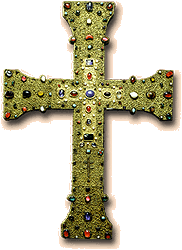 |
Abbey of Valasse (Seine-Maritime) Reliquary 11th century |
A receptacle for a fragment of the cross of Christ, this reliquary is in the form of Latin cross with the four extremities enlarged. It is made of two crosses in the same format the one embedded in the other. The small central cross, which contained the relic, is the oldest part. It is in the Ottonian style, and in all probability was manufactured in the empire in the first quarter of the 11th century. According to tradition, it was given by the Empress Mathilda (1104-1167) to the abbey of Valasse which she had founded in 1157. It is articulated on the obverse by large precious stones arranged in two perpendicular lines around which are set filigree patterns which intertwine in scrolls. On the reverse it is covered with sliver plates, stamped with monograms of Christ and four-leafed motifs, acquired during a 15th century restoration.
In the 12th century, this little cross was embedded into a large cross-cum-case and transformed into a precious processional cross made in the Plantagenet empire. This large cross is ornamented on the obverse with a filigree network embellished with rosettes, arranged at random. Medium sized stones follow each other in the middle of the two axes. Other smaller stones emphasise the border here and there. On the reverse, the filigree network is simpler than on the obverse: there are no rosettes, but the technique is the same.Dimensions of the object
H. 47 cm ; l. 23.5 cmBibliography
- Exhibitions: Les trésors des églises de France, Paris 1965, n°213, p.119 ; Trésors des abbayes Normandes, Rouen et Caen 1979, n°296, p. 281 à 284Location
Musée départemental des Antiquités de Rouen, Seine-Maritime
inv. 443Photography
François Dugué, Rouen